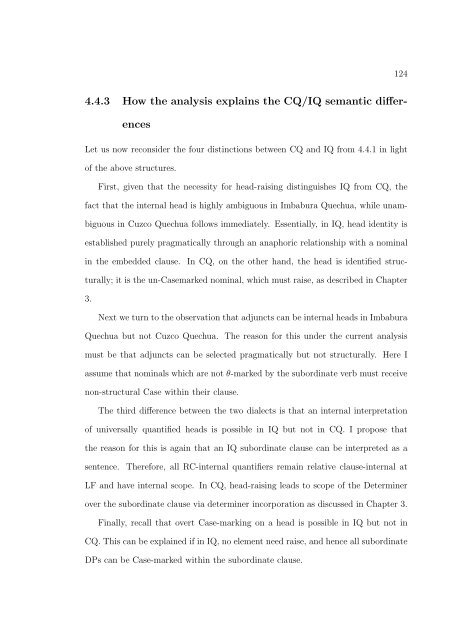the syntax and semantics of relativization and quantification
the syntax and semantics of relativization and quantification
the syntax and semantics of relativization and quantification
Create successful ePaper yourself
Turn your PDF publications into a flip-book with our unique Google optimized e-Paper software.
124<br />
4.4.3 How <strong>the</strong> analysis explains <strong>the</strong> CQ/IQ semantic differences<br />
Let us now reconsider <strong>the</strong> four distinctions between CQ <strong>and</strong> IQ from 4.4.1 in light<br />
<strong>of</strong> <strong>the</strong> above structures.<br />
First, given that <strong>the</strong> necessity for head-raising distinguishes IQ from CQ, <strong>the</strong><br />
fact that <strong>the</strong> internal head is highly ambiguous in Imbabura Quechua, while unambiguous<br />
in Cuzco Quechua follows immediately. Essentially, in IQ, head identity is<br />
established purely pragmatically through an anaphoric relationship with a nominal<br />
in <strong>the</strong> embedded clause. In CQ, on <strong>the</strong> o<strong>the</strong>r h<strong>and</strong>, <strong>the</strong> head is identified structurally;<br />
it is <strong>the</strong> un-Casemarked nominal, which must raise, as described in Chapter<br />
3.<br />
Next we turn to <strong>the</strong> observation that adjuncts can be internal heads in Imbabura<br />
Quechua but not Cuzco Quechua. The reason for this under <strong>the</strong> current analysis<br />
must be that adjuncts can be selected pragmatically but not structurally. Here I<br />
assume that nominals which are not θ-marked by <strong>the</strong> subordinate verb must receive<br />
non-structural Case within <strong>the</strong>ir clause.<br />
The third difference between <strong>the</strong> two dialects is that an internal interpretation<br />
<strong>of</strong> universally quantified heads is possible in IQ but not in CQ. I propose that<br />
<strong>the</strong> reason for this is again that an IQ subordinate clause can be interpreted as a<br />
sentence. Therefore, all RC-internal quantifiers remain relative clause-internal at<br />
LF <strong>and</strong> have internal scope. In CQ, head-raising leads to scope <strong>of</strong> <strong>the</strong> Determiner<br />
over <strong>the</strong> subordinate clause via determiner incorporation as discussed in Chapter 3.<br />
Finally, recall that overt Case-marking on a head is possible in IQ but not in<br />
CQ. This can be explained if in IQ, no element need raise, <strong>and</strong> hence all subordinate<br />
DPs can be Case-marked within <strong>the</strong> subordinate clause.
















